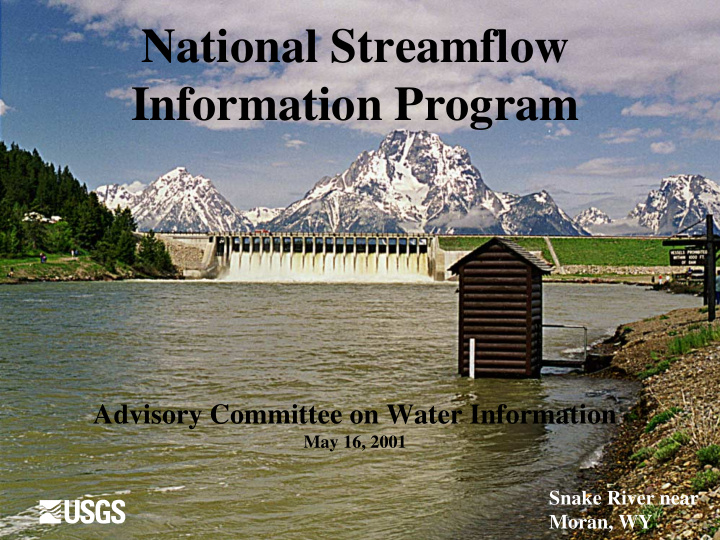



National Streamflow Information Program Advisory Committee on Water Information May 16, 2001 Snake River near Moran, WY
Network Funding Process • Coop. funding with over 800 partners. – Generates interest in the network. – Keeps network relevant to local needs. – Generates funds for the network. • Less control by USGS over network. – Loss of long-term gaging stations – Less ability to meet national goals.
Fiscal Year 2000 Funding Sources for USGS Streamgaging Program USGS Federal Other Federal Program $7M Agencies $26M USGS-Federal Match Cooperative Program $27M State and Local TOTAL Agencies $39M $99 Million
Number of Inactive Long-Record Streamgages 2500 INACTIVE STATIONS WITH 30 OR MORE YEARS OF RECORD 2000 1500 1000 500 0 1920 1930 1940 1950 1960 1970 1980 1990 2000 YEARS
National Streamflow Information Program
Federal Interests Evaluated • Interstate and international transfers • Water budgets • Flooding • Water quality • Long-term changes
Flooding 100 90 Goal: Provide flow information for populations 80 at risk from flooding 70 60 50 40 30 20 Metric: NWS service locations supported by gages 10 PASS FAIL 0 1921 1926 1931 1936 1941 1946 1951 1956 1961 1966 1971 1976 1981 1986 1991 1996
What are the Issues? • Network’s ability to meet long-standing Federal goals has declined because of: – an absolute loss of streamgages – and our declining ability to continue operating high-priority streamgages when partners discontinue funding • New issues and new technology have increased the demand for streamflow information.
What are the Issues? (2) • New technologies are needed to: – Improve reliability – Decrease costs – Decrease uncertainty
National Streamflow Information Program 1. Enhanced nationwide streamgaging network 2. Intensive data collection during major floods and droughts 3. Periodic regional and national assessments 4. Streamflow information delivery to customers 5. Methods development and research
#1 Streamgaging Network • USGS-funded streamgages to meet 5 basic federal goals • Partnership-funded streamgages to achieve more complete coverage than the USGS- funded streamgages provide • Shared costs by USGS, State, and local agencies and other Federal agencies • Full support for network infrastructure from Federal funds – (40% savings)
#2 Floods and Droughts • Temporary streamgages • Characterize the event: Precipitation, Stage, Discharge, Sediment, Water Quality, Ground Water • Document changes in channels and riparian zones
# 3 Regional & National Assessments • Regional studies for low-flow and flood statistics: updated every decade to include new data and changing conditions • National studies of streamflow trends: related to climate and land-use factors
#4 Information Delivery • Improve reliability through “mirror” servers • Complete geospatial framework for rivers (NHD) and watersheds (hydrologic units) • “Point and click” streamflow characteristics • Make data available at time resolution of actual data collection (e.g. 15-minute)
#5 Research & Development • Non-contact streamflow measurement • Improve use of acoustic methods • Improve methods for characterizing uncertainty • Make streamflow calculation process more effective: more use of models and graphics
Five Federal Goals To Be Met By USGS-Funded Streamgages • Interstate and International Waters • Streamflow Forecasts • River Basin Outflows • Sentinel Watersheds • Water Quality
Goal 1 – Support National Water Quality Networks Streamflow data make water quality data more useful. Operate a streamgage at or near each site in USGS water-quality monitoring networks: Hydrologic Benchmark, NASQAN, and NAWQA Low-Intensity Phase.
Goal 2 -- Streamflow Information for Borders and Compacts Information on streamflow crossing State and International borders is used for interstate and international water management and adjudications. Treaties and compacts establish measuring points for water distribution and allocation. Operate a streamgage on the reach mandated in all compacts and decrees, and at State and International boundaries on all rivers with drainage areas greater than 500 sq. mi.
Goal 3 -- Quantify Flow From Major River Basins Outflows from the 335 major river basins are important to understanding water yield and flux to the ocean, estuaries, and Great Lakes. Operate a streamgage near the mouth of each of the Nation’s hydrologic accounting units. Use two streamgages if no one streamgage covers more than 50 percent of the unit.
Goal 4 -- Sentinel Watersheds Gaged to Estimate Regional Streamflow Characteristics Streamgages with long-term record, unaffected by regulation or diversion, are needed to estimate regional flow statistics and trends. Operate at least one streamgage in each of the 828 unique ecological/hydrological areas of the Nation.The watershed for that streamgage should be entirely within the unique ecological/hydrologic area.
Goal 5 -- Support Streamflow Forecasting Streamflow data are needed to develop and calibrate forecasting models and make flow forecasts for flooding and water supply. Operate a streamgage at or near each National Weather Service forecast site .
USGS Funded Streamgages Preliminary Design: January 2001
National Streamflow Information Program USGS- Funded Streamgages Active USGS Site Inactive USGS Site Other Agency Site New/Proposed Site
Progress Towards NSIP in FY2000 and FY2001 • 37 new streamgages; • 73 reactivated streamgages; • 127 streamgages with upgraded equipment; • 15 flood-hardened streamgages; • 40 streamgages with extended rating curves; • ~ 100 existing streamgages with full USGS funding.
Status of Streamgages Designated to be USGS funded 4500 Stations funded by partners 4000 NUMBER OF STREAMGAGES Stations funded entirely by USGS 3500 3000 2837 2755 2727 2500 4420 2000 2315 2335 2326 1500 1000 500 522 420 401 0 1999 2000 2001 Future YEAR
NSIP Funding 14.9 15 System Enhancements & Support 3.7 New/Reactivated Station EXPENDITURES $M Station Operation & Maintenance 10 3.4 6.2 0.7 4.6 5 1.2 7.8 4.6 4.3 0 1999 2000 2001 YEAR
NSIP Funding: Capital 70 64 Capital Cost Investments ($M) 60 50 $ Millions 40 30 20 10 4.9 1.4 0 0 1999 2000 2001 Full NSIP Implementation Year
NSIP Funding: Operations 90 Annual Operations ($M/year) 78 80 70 60 $ Millions 50 40 30 20 10 10 4.8 4.6 0 1999 2000 2001 Full NSIP Implementation Year
Minnesota River near Jordan, MN, April 17, 2001
Recommend
More recommend